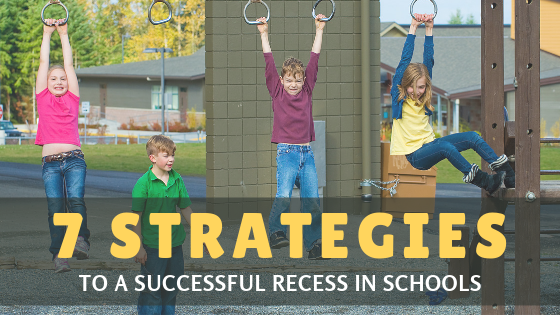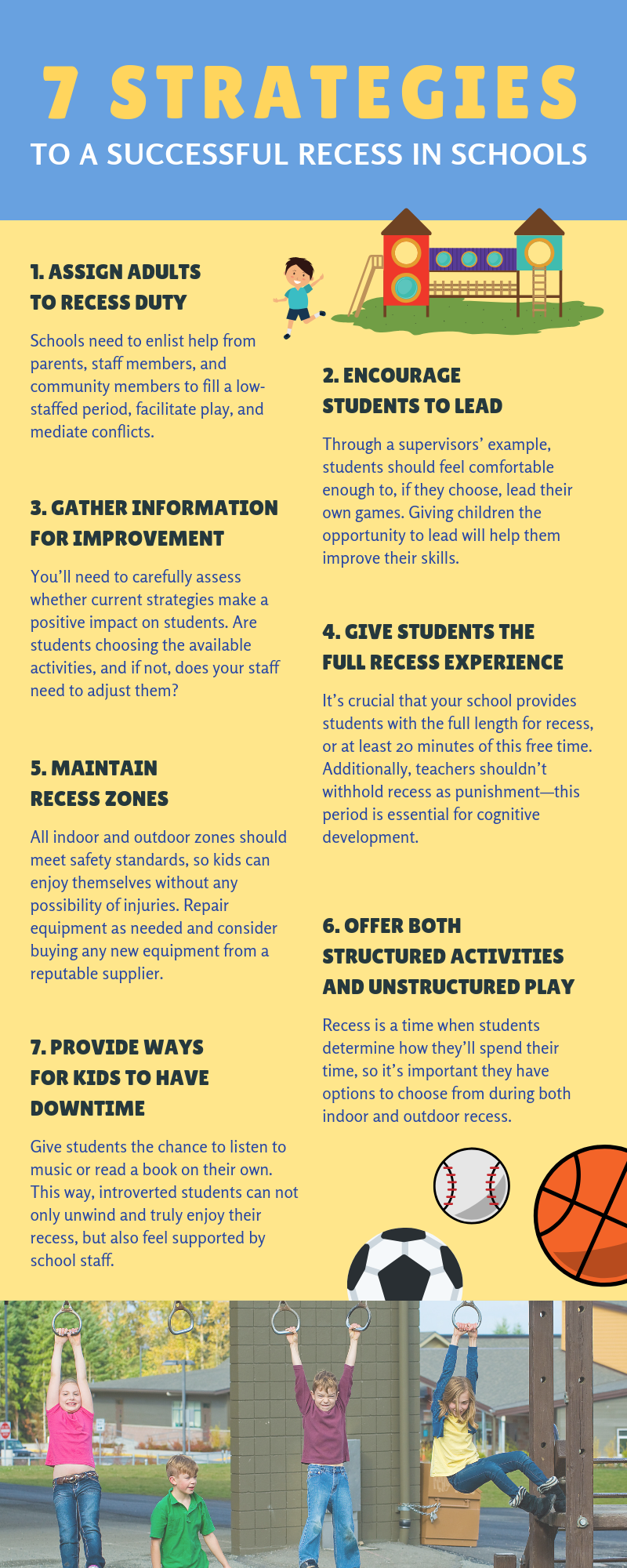
Recess is a critical part of every student’s school day. We previously covered how recess can positively impact students’ learning abilities in the classroom, however, recess isn’t always created equal. Sometimes it may not include enriching activities, and some schools remove recess entirely. In this post, we want to outline seven strategies to a successful recess in schools, as defined by the Center for Disease Control and Prevention (CDC) and the Society of Health and Physical Educators (SHAPE) America.
Assign Adults to Recess Duty
When it comes to recess plans, adequate supervision and leadership is necessary, as bullying and injuries tend to occur without adult supervision. Schools need to enlist help from parents, staff members, and community members to fill a low-staffed period, facilitate play, and mediate conflicts. Above all, these figures are experts in recess, promoting safety and reiterating expected behaviors during this time of the school day. These individuals circulate throughout the students’ recess, constantly surveying the kids and teaching expected types of play in specific areas of the playground. They’ll also reinforce positive behavior, encouraging children to cooperate during this time. All supervisors should have ongoing training from school administrators, so they can provide maximum support to students and give them the best possible recess.
Encourage Students to Lead
Through a supervisors’ example, students should feel comfortable enough to, if they choose, lead their own games. Schools should especially consider training older students to lead younger kids in these activities, if it’s an option. Giving children the opportunity to lead will help them improve their skills, promote student involvement, and display positive behavior to their peers.
Gather Information for Improvement
To understand the improvements your school can make to its recess practices, you must track progress. You’ll need to carefully assess whether current strategies make a positive impact on students. Are students choosing the available activities, and if not, does your staff need to adjust them? Does your school offer activities that contribute to the recommended 60 minutes of daily exercise? Is your school providing ample space for recess? After determining these issues, make changes to recess plans and inform students and their families.
Give Students the Full Recess Experience
Recess is beneficial to all students, so it’s crucial that your school provides them with the full length for recess, or at least 20 minutes of this free time. Teachers shouldn’t have to replace recess with schoolwork or withhold recess as punishment—this period is essential for cognitive development, and physical education shouldn’t replace it.
Additionally, if some students want to play outdoors and the weather doesn’t cooperate, students should still have recess indoors. Like outdoor recess, indoor recess gives kids permission to release pent-up energy before another round of lessons. Investigate if a large space, like the gym, is available during recess time in these cases. Finally, inclusion during recess is essential, as all students deserve a daily mental break. Alter activities so that everybody can participate, especially students with special needs.
Maintain Recess Zones
All indoor and outdoor zones should meet safety standards, so kids can enjoy themselves without any possibility of injuries. Repair equipment as needed, and if your school is thinking about purchasing new equipment, consider buying from a reputable supplier.
The cleanest recess zones are sure to receive increased traffic. After all, nobody wants to play in an area where they can catch all kinds of illnesses! Sanitize student-occupied spaces, and if you want to clean larger equipment such as commercial playsets, have a professional company aid you in doing so.
Offer Both Structured Activities and Unstructured Play
It’s no secret that every school does recess differently. A survey conducted by the International Play Equipment Manufacturers Association’s Voices of Play initiative confirms that “The primary location of recess, according to 87 percent of those surveyed, is outdoors and on a playground, and 89 percent said children are supervised all the time during recess. About half do not have structured recess (meaning they participate in activities chosen by the teacher or other school faculty).”
Above all, recess is a time when students determine how they’ll spend their time, so it’s important they have options to choose from during both indoor and outdoor recess. For students who prefer structured activities, set up a variety of games before teachers release students. These structured activities teach kids to follow rules, help others, take turns, and, if they lose, be a “good sport.” They’re also effective in preventing roughhousing and social issues. It’s also crucial to offer unstructured play to those who want to let their imaginations run wild. Give kids the opportunity to play on the swings, walk laps on the blacktop, or simply have fun with hula hoops, jump ropes, balls, or other equipment.
Provide Ways for Kids to Have Downtime
No two kids have the same interests. While some kids desperately crave the opportunity to interact with their peers after a few lessons, others may need some quiet time before they return to class. Allow students to have this downtime if necessary. For example, give them the chance to listen to music or read a book on their own. This way, introverted students can not only unwind and truly enjoy their recess, but also feel supported by school staff.
Through incorporating these strategies into your school’s recess, you’re sure to notice the following:
- Overall improved behavior from students. Kids can benefit from additional social interaction opportunities, as it promotes positive behavioral changes. For instance, successful recess can increase students’ participation in class as well as their eagerness to learn.
- Fewer instances of bullying. Bad behavior comes from a myriad of things, but it could also simply stem from feeling antsy. Fortunately, successful recess includes activities to minimize students’ fidgeting habits. Additionally, adults who monitor recess can stop aggressive behavior before it happens.
- Smoother transitions between learning and free time. Since recess is specifically for play, students will be better able recognize that class time is when they must pay attention and recess is when they can welcome distractions.


